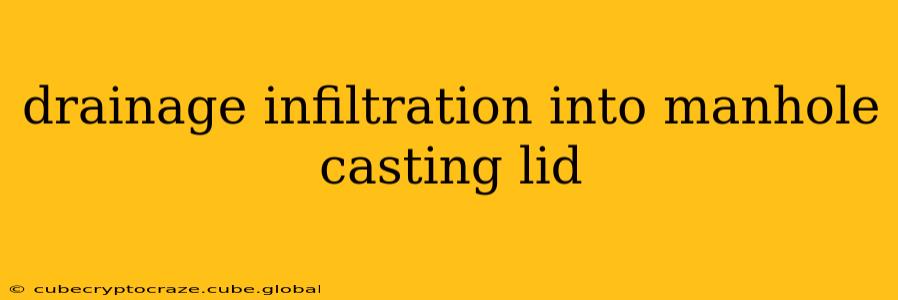Manhole casting lids are critical components of drainage systems, providing access for maintenance and inspection. However, infiltration of drainage water into the space between the lid and the manhole frame is a common problem, leading to various issues like structural damage, unsanitary conditions, and safety hazards. This comprehensive guide explores the causes of this infiltration, effective prevention methods, and solutions for existing problems.
What Causes Drainage Infiltration into Manhole Casting Lids?
Several factors contribute to water infiltrating the space around manhole casting lids:
-
Poor Lid Fit: A primary cause is a poorly fitting lid. Over time, lids can settle, become damaged, or simply not be installed correctly, creating gaps that allow water entry. This is exacerbated by ground settlement or shifting.
-
Improper Gasketing: Many manhole covers utilize gaskets to create a watertight seal. Deterioration of these gaskets due to age, chemical exposure, or UV degradation renders them ineffective, permitting water infiltration.
-
Corrosion and Degradation: The manhole frame and lid materials, often cast iron or concrete, are susceptible to corrosion and degradation, especially in aggressive soil environments. This can lead to cracks and gaps that facilitate water ingress.
-
Excessive Ground Water: High groundwater levels can exert pressure, forcing water underneath the lid and into the surrounding area. This is particularly problematic in low-lying areas or regions with heavy rainfall.
-
Poor Construction Practices: Inaccurate installation techniques, including insufficient compaction around the frame or incorrect lid placement, can create voids or gaps that allow water infiltration.
-
Root Intrusion: Tree roots searching for moisture can penetrate the surrounding soil, potentially lifting or displacing the manhole casting lid, creating pathways for water entry.
How Can I Prevent Drainage Infiltration into Manhole Casting Lids?
Proactive measures are key to preventing infiltration problems:
-
Regular Inspection and Maintenance: Regular visual inspections should identify potential issues like cracked lids, damaged gaskets, or signs of settlement before they become significant problems. Prompt repairs are crucial.
-
High-Quality Materials: Specifying durable, corrosion-resistant materials for manhole frames and lids during construction is essential for long-term performance.
-
Proper Installation Techniques: Adherence to strict installation guidelines, ensuring proper compaction of the surrounding soil and accurate lid placement, prevents the creation of voids that facilitate infiltration.
-
Effective Gasketing: Using high-quality, durable gaskets designed to withstand environmental conditions is vital. Regular inspection and replacement of gaskets as needed is also recommended.
-
Groundwater Control: In areas with high groundwater levels, implementing effective drainage solutions around the manhole can help mitigate pressure on the lid and reduce infiltration.
-
Root Barriers: Installing root barriers around manholes can prevent tree roots from damaging the structure and creating pathways for water infiltration.
What Are the Solutions for Existing Infiltration Problems?
Addressing existing infiltration requires appropriate solutions based on the cause:
-
Lid Replacement: Damaged or poorly fitting lids should be replaced with new, properly sized units.
-
Gasket Replacement: Replacing deteriorated gaskets with new, compatible ones can effectively restore the watertight seal.
-
Grouting and Sealing: Cracks or gaps in the manhole frame or lid can often be repaired by grouting or applying a suitable sealant.
-
Frame Repair or Replacement: Severely damaged frames might require repair or complete replacement to ensure a proper seal.
-
Drainage Improvement: Improving overall drainage in the area can reduce pressure on the manhole system and minimize infiltration.
-
Hydraulic Sealants: Specialized hydraulic sealants can be injected under pressure to fill gaps and cracks, providing a waterproof seal.
What are the Consequences of Ignoring Drainage Infiltration?
Ignoring drainage infiltration can lead to several serious consequences:
-
Structural Damage: Continuous water infiltration can weaken the manhole structure, potentially causing collapse or failure.
-
Public Health Concerns: Standing water in or around manholes can become a breeding ground for mosquitoes and other disease vectors, posing public health risks.
-
Environmental Contamination: Infiltration can lead to the contamination of groundwater with pollutants from the drainage system.
-
Roadway Damage: Water accumulating around manholes can undermine the pavement, leading to surface damage and potential sinkholes.
-
Increased Maintenance Costs: Addressing infiltration problems later often requires more extensive and costly repairs than preventative maintenance.
By addressing the causes of drainage infiltration and implementing effective preventative and remedial measures, we can ensure the longevity and functionality of our drainage systems, safeguarding public health and infrastructure. Regular inspection and proactive maintenance are key to avoiding costly and potentially hazardous problems.
